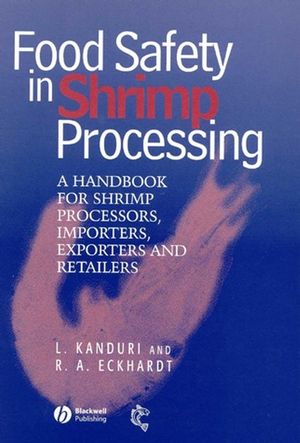Food Safety in Shrimp Processing: A Handbook for Shrimp Processors, Importers, Exporters and RetailersISBN: 978-0-85238-270-7
Hardcover
184 pages
June 2002, Wiley-Blackwell
 This is a Print-on-Demand title. It will be printed specifically to fill your order. Please allow an additional 10-15 days delivery time. The book is not returnable.
|
||||||
Preface.
Acknowledgments.
Introduction to Hazard Analysis and Critical Control Points (HACCP).
What is HACCP?.
How is the HACCP based approach different from traditional food safety systems?.
Scope of HACCP.
Various federal regulatory agencies and their role in regulating seafood in the United States.
United States Department of Health and Human Services (DHHS)/Food and Drug Administration (FDA).
United States Department of Commerce (USDC)/National Oceanic and Atmospheric Administration (NOAA)/National Marine Fisheries Service (NMFS).
Other Federal Agencies.
HACCP in the United States.
Implementation of HACCP in the United States.
Rationale for the FDA's adoption of a HACCP based approach to Seafood Inspection.
What are the practical implications to American seafood processors and seafood processors from other countries?.
Summary of the US HACCP regulations.
What are the benefits attributed to the HACCP regulations?.
HACCP and Export Health Certificate.
Who is excluded?.
HACCP Vs ISO 9000/14000 series of standards.
Relevance of HACCP to shrimp culture and processing.
Current world status of HACCP in shrimp culture and processing.
Implementing Sanitation and related Programs as Pre-requisite to HACCP.
Introduction.
Sanitation, the most important pre-requisite to HACCP, and what it actually means to a processor?.
What are the benefits of sanitation?.
Regulatory requirements.
How to comply with sanitation requirements under the new HACCP regulations?.
2.5.1 A. Premises.
Sanitary facilities.
Water quality.
Transportation and Storage (Raw materials, ingredients and packaging materials).
Equipment (Design, installation and maintenance).
Personnel (Training in manufacturing controls and hygienic practices).
Sanitation and pest control.
How to develop sanitation SSOPs to comply with the proposed HACCP based regulations?.
Cleaning schedule.
Wash facilities.
Personnel.
Restrooms.
Water supply.
Waste disposal.
Chemicals.
Pest control.
Records.
Developing a HACCP Plan.
What must be in a HACCP plan and how to implement a HACCP-based system?.
Assembling a HACCP team and assigning responsibilities.
Developing an organizational chart and narrative.
Describing the end product, intended use and its distribution.
Identifying product ingredients and incoming materials.
Developing an operational flow chart depicting the control points of a process in question.
Developing a plant schematic.
Developing a HA worksheet following the seven principles of HACCP.
First principle of HACCP-Identify potential Hazards and appropriate Control Measures.
Second principle of HACCP-Determine Critical Control Points (CCPs).
Third principle of HACCP-Establish Critical Limits (CLs).
Fourth principle of HACCP-Establish Monitoring Procedures (MPs).
Fifth principle of HACCP-Set Corrective Action (CA) Protocols to deviations.
Sixth principle of HACCP-Establish Verification Procedures.
Seventh principle of HACCP-Establish Procedures for Record keeping.
HACCP in Shrimp processing.
Introduction to shrimp processing.
Background.
Major cold-water shrimp species.
Tropical shrimp species.
Fresh water shrimp species.
Product/Market forms and definitions.
Processing (Raw).
Grading (size and counts).
Beheading.
Peeling and de-veining.
Processing (Cooked).
Dried Shrimp.
Canning.
Breading.
Freezing.
4.7.1 Glazing.
Cold storage.
Ice production and storage.
HACCP in shrimp processing.
General guidelines in developing a HACCP plan.
General concepts of sampling and monitoring.
Introduction.
Basics of sampling.
Major disadvantages of sampling.
When sampling is used?.
When sampling is most effective?.
Definitions of basic sampling terms.
Types of sampling plans.
Attribute plans.
Ten Percent Rule.
Re-sampling.
Statistical Process/Quality Control.
Sampling Procedures and Monitoring for Organoleptic, Physical and Chemical Quality.
Sampling schedule.
Organoleptic analysis.
Physical Requirements of Organoleptic Examination.
Other considerations.
Procedure.
Regulatory action guidance.
Physical testing.
Net weight.
Determination of the physical parameters.
Determination of filth in shrimp.
Flesh content of frozen breaded shrimp.
Standard cooking procedure.
Chemical testing.
Phosphorus (Phosphates).
Sulfites.
Indole test for decomposition.
Monitoring for microbiological quality.
Introduction.
what are Microorganisms?.
Features that are unique to Microorganisms.
Factors that influence the growth of Microorganisms.
External Factors.
Internal Factors of the substrate.
Interaction between growth factors.
Microorganisms and their effect on humans.
Pathogenic.
Spoilage causing.
Classification of bacteria.
Stain.
Based on their oxygen requirements.
Microbiological testing procedures.
Standard plate count (SPC)/or total viable count (TVC)/or total plate count (TPC)/or aerobic plate count (APC).
Total coliform and E. coli counts.
Salmonella spp.
Listeria monocytogenes.
Staphylococcus aureus.
References.
Appendices.
Index



